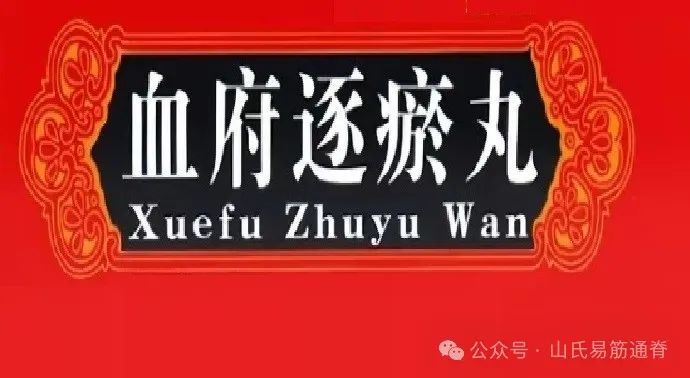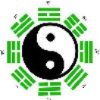The theory of blood stasis originated in the “Neijing”. For example, the term “evil blood” in the “Ling Shu” is the earliest record of stasis blood. The “Suwen* Miao Ci Lun” states: “If a person falls, evil blood remains inside, causing fullness and distension in the abdomen, and they cannot move forward or backward; first drink a purgative medicine.” The “Ling Shu* Five Evils” states: “If the evil is in the liver, then there will be pain in both sides, coldness, and evil blood inside; during the menstrual cycle, it will cause swelling at the joints. If cold remains alone, the blood will coagulate and weep, and if it coagulates, the pulse will not flow.” The “Suwen* Pulse Essentials” states: “The pulse is the residence of blood… if it is rough, it causes heart pain.” Therefore, although the term stasis blood is not found in the “Neijing”, it refers to evil blood and retained blood, and discusses the causes of stasis blood and the symptoms it causes in several chapters. In terms of treatment, the “Neijing” also proposes basic principles—primarily focusing on dredging and guiding. For instance, the “Suwen* Yin Yang Correspondence” points out: “If the blood is full, it should be resolved.” The “Suwen* Essential Prescriptions” states: “Dredge the blood and qi, allowing them to adjust and reach peace,” “If it is hard, it should be cut; if it is clotted, it should be dispersed; if it is retained, it should be attacked.” These records have greatly inspired later generations of physicians and have continuously guided clinical and research work. The “Hundred Prescriptions for Treating Diseases” (unearthed from the Han tomb in Wuwei, Gansu) from the same period as the “Neijing” includes the fifth prescription, the “Stasis Blood Formula”, which records many Chinese herbs used clinically before the “Bencao Jing”, including blood-activating and stasis-resolving herbs such as Dang Gui (Angelica Sinensis), Dan Pi (Moutan Cortex), Da Huang (Rhubarb), Niu Xi (Achyranthes), Chuan Xiong (Ligusticum), and Wu Ling Zhi (Flying Squirrel Feces). This indicates that the method of activating blood and resolving stasis had already been used clinically before this time. The first Chinese herbal medicine book, “Shennong Bencao Jing”, records about 30 commonly used blood-activating and stasis-resolving medicines. Zhang Zhongjing of the Han Dynasty is the founder of the theory of blood stasis. In the “Jinkui Yaolue”, in the chapter on “Palpitations, Hematemesis, and Blood Stasis Disease”, he summarizes the experiences of predecessors and first proposes the term “stasis blood”, describing several main symptoms and pulse signs of stasis blood in the treatment of blood retention, blood bi, deficiency labor, symptoms of masses, and postpartum abdominal pain. In other chapters, he discusses the causes of stasis blood and its treatment; in the “Shanghan Lun”, he elaborates on the blood stasis syndrome in detail. He pioneered the differentiation and treatment of stasis blood and formulas, establishing prescriptions such as Gui Zhi Fu Ling Wan, Xia Yu Xue Tang, Tao Ren Cheng Qi Tang, Di Dang Tang, and Bie Jia Jian Wan, opening up new fields for the treatment of miscellaneous diseases, cold damage, and gynecological blood stasis, setting a model for the later application of blood-activating and stasis-resolving medicines. These theories and practices have had a significant impact on later medicine.
1. The Concept of Stasis Blood
“Stasis blood” and “blood stasis” are different concepts. Blood stasis refers to a pathological state where blood flow is obstructed or stagnant, belonging to the concept of pathogenesis. Stasis blood is a pathological product that can lead to new pathological changes, belonging to the concept of etiology.
Stasis blood is a pathological product formed during the disease process and is also a pathogenic factor for certain diseases. Its formation can be caused by Qi deficiency, Qi stagnation, blood cold, and blood heat, all of which can obstruct blood flow and lead to stasis blood. Various external injuries can damage the skin and internal organs, causing blood to deviate from its normal channels and accumulate in the body, forming stasis blood. The clinical manifestations of stasis blood include pain like needle pricks, fixed pain, tenderness, and worsening at night; masses on the surface appear bluish-purple, while those in the abdomen are hard and immovable, referred to as symptom accumulation; recurrent bleeding with dark purple color, mixed with blood clots, or black stools resembling tar; a dark complexion, skin with uneven texture, purple lips and nails, or skin purpura, spider veins, or visible blue veins in the abdomen, or swollen and painful blue veins in the lower limbs; women may experience scanty menstruation with dark purple clots or amenorrhea; the tongue may appear dark purple, or show stasis spots and stasis points, with a thin, rough pulse or intermittent pulse.
2. Formation of Stasis Blood
The normal circulation of blood is closely related to the functions of the heart, lungs, liver, and spleen, the promoting and consolidating effects of Qi, the patency of the meridians, and internal and external environmental factors such as cold and heat. Any internal or external factors that can affect the normal circulation of blood, causing blood flow obstruction or leading to blood deviating from its normal channels and accumulating, can lead to the formation of stasis blood.
1. Blood Loss Leading to Stasis
Various external injuries, such as falls, cuts, surgical trauma, etc., can cause blood vessels to rupture and bleed, resulting in blood deviating from its normal channels; or other reasons, such as the spleen not controlling blood, the liver not storing blood, leading to bleeding, and women experiencing menstrual flow obstruction or miscarriage. If the blood that is lost does not drain out of the body or dissipate in time, it will accumulate in the body and form stasis blood.
2. Qi Stagnation Leading to Stasis
When Qi flows, blood flows; when Qi stagnates, blood stasis occurs. If emotions are repressed, Qi movement is obstructed, or phlegm and fluids accumulate in the body, blocking the meridians, it will cause blood flow obstruction, leading to blood accumulating in certain areas of the body and forming stasis blood. The “Xue Zheng Lun* Hematemesis” states: “Qi is the commander of blood, blood follows it to flow; blood is the guardian of Qi, Qi is quiet when it is obtained. If Qi is blocked, blood coagulates; if Qi is deficient, blood escapes; if Qi is forced, blood runs away.”
3. Deficiency Leading to Stasis
The division of Qi and Yin-Yang is the driving force that promotes and regulates blood circulation. If Qi is deficient, blood circulation will be weak; if Yang is deficient, the meridians will lose warmth and become stagnant; if Yin is deficient, the meridians will lose moisture and become rigid. Body fluids and blood share the same source and transform into each other; if body fluids are deficient, blood will not be adequately filled, leading to poor blood circulation. Therefore, the deficiency of Qi and body fluids can also cause blood flow obstruction, leading to blood accumulating in certain areas of the body and forming stasis blood.
4. Blood Cold Leading to Stasis
Blood flows when it is warm and coagulates when it is cold. If external cold pathogens invade the blood vessels, or if internal cold is excessive, the blood vessels will constrict, causing blood to coagulate and flow poorly, leading to blood accumulating in certain areas of the body and forming stasis blood. As stated in the “Ling Shu* Abscesses”: “If cold pathogens invade the meridians, blood weeps; if blood weeps, it does not flow.” The “Yilin Gai Cuo* Accumulation” states: “If blood is affected by cold, it coagulates into clots.”
5. Blood Heat Leading to Stasis
If external heat pathogens invade, or if internal Yang is excessive and transforms into heat, entering the blood, blood heat will accumulate, scorching the body fluids in the blood, making the blood viscous and causing poor circulation; or heat will scorch the meridians, forcing blood to flow erratically, leading to internal bleeding, causing blood to stagnate in certain areas of the body and not disperse, forming stasis blood. The “Yilin Gai Cuo* Accumulation” states: “If blood is affected by heat, it is boiled into clots.”
1. Pathogenic Characteristics of Stasis Blood
Once stasis blood forms and accumulates in the body, it not only loses its nourishing function but can also lead to new pathological changes. The pathogenic characteristics of stasis blood are mainly reflected in the following aspects.
1. Easily obstructs Qi movement
Blood is the mother of Qi, and blood can carry Qi; therefore, once stasis blood forms, it will inevitably affect and worsen Qi stagnation, known as “blood stasis must accompany Qi stagnation.” Qi is the commander of blood; Qi stagnation can also cause local or systemic blood flow obstruction, leading to a vicious cycle of blood stasis and Qi stagnation. For example, in the case of local trauma, damaged blood vessels can lead to stasis, causing Qi stagnation in the injured area, resulting in local bruising, swelling, and pain.
2. Affects blood vessel circulation
Stasis blood is a pathological product of abnormal blood circulation, but once stasis blood forms, whether it stagnates within the vessels or accumulates outside the vessels, it can affect the functions of the heart, liver, and other organs, leading to abnormal blood circulation locally or systemically. For instance, if stasis blood obstructs the heart, blood circulation will be hindered, causing chest tightness and heart pain; if stasis blood accumulates in the liver, it can obstruct the liver’s meridians, causing Qi and blood circulation disorders, hence the saying “evil blood returns to the liver”; if stasis blood obstructs the meridians, it can damage the vessels, leading to purple and dark bleeding; if stasis blood obstructs the channels, Qi and blood circulation will be impaired, leading to symptoms such as cyanosis of the lips and nails, skin purpura, stasis points, and a rough pulse.
3. Affects the generation of new blood
Stasis blood is a pathological product that has lost its nourishing and moistening function. When stasis blood obstructs the body, especially if it does not disperse for a long time, it will severely affect the circulation of Qi and blood, leading to the organs losing nourishment and dysfunction, which will inevitably affect the generation of new blood. Hence, there is a saying: “If stasis blood does not go, new blood cannot be born.” Therefore, individuals with long-term stasis often exhibit clinical features such as uneven skin texture and lack of luster in hair. The “Xue Zheng Lun* Differences Between Men and Women” states: “If stasis blood does not circulate, new blood cannot physiologically be generated… Stasis blood must be removed for new blood to easily be generated; when new blood is generated, stasis blood will naturally dissipate.” This reveals the dialectical relationship between stasis blood obstruction and the generation of new blood to a certain extent.
4. Fixed disease location, diverse symptoms
Once stasis blood stagnates in a certain organ or tissue, it is often difficult to disperse in time, thus its pathogenicity also has the characteristic of a relatively fixed disease location, such as localized stabbing pain, fixed and immovable masses, or the formation of symptom accumulation that does not dissipate for a long time. Moreover, the location of stasis blood obstruction varies, with different causes and accompanying evils, leading to different pathological manifestations. For example, if stasis obstructs the heart, blood circulation will be impaired, leading to chest tightness and heart pain; if stasis obstructs the lungs, it will disrupt the descending and dispersing functions, or damage the vessels, leading to symptoms such as chest pain, shortness of breath, and hemoptysis; if stasis obstructs the liver, Qi stagnation will occur, leading to blood sea obstruction and meridian stasis, resulting in symptoms such as rib pain and symptom accumulation; if stasis obstructs the uterus, it will lead to menstrual obstruction, resulting in symptoms such as dysmenorrhea, amenorrhea, and dark purple menstrual blood with clots; if stasis obstructs the limbs and skin, it will lead to swelling and pain with cyanosis; if stasis obstructs the brain, it can cause sudden fainting, loss of consciousness, or severe sequelae such as dementia and speech difficulties. In addition, long-term stasis blood obstruction can also transform into heat. Therefore, it is said that stasis blood causes various diseases and symptoms.
2. Symptom Characteristics of Stasis Blood Pathogenicity
Although the symptoms caused by stasis blood are complex and varied, their main characteristics can be summarized as follows: ① Pain: Generally manifested as stabbing pain, fixed pain, tenderness, and especially severe pain at night. ② Masses: Stasis blood accumulating under the skin or inside the body can lead to masses, which are often fixed and immovable. If on the surface, they may appear bluish-purple and swollen, referred to as hematomas; if in the body cavity, they may feel hard and immovable, referred to as symptom accumulation. ③ Bleeding: Some patients with stasis blood may exhibit bleeding, usually in small amounts and not smooth, with dark purple blood color, or mixed with blood clots. ④ Dark purple color: This includes a dark complexion, cyanosis of the lips and nails; and a dark purple tongue, or a tongue with stasis spots and stasis points. ⑤ It may also present with uneven skin texture and certain abnormalities in the pulse, such as a rough pulse or intermittent pulse.
【Eight Methods for Treating Stasis Blood】 Based on the etiology and pathology of stasis blood, combined with clinical symptoms, the treatment of stasis blood is divided into eight methods. 1. Clearing Heat and Activating Blood Method This method is suitable for early infectious lesions accompanied by fever symptoms and is one of the most commonly used methods for treating stasis blood in clinical practice. All surgical abscesses, carbuncles, and sores are caused by Qi stagnation and blood stasis transforming into heat, as “all sores are formed due to Qi and blood stagnation”; among them, heat toxins and stasis blood are the most significant. Therefore, the method of clearing heat and detoxifying or purging fire and detoxifying combined with activating blood and cooling blood is the main treatment for various acute abscesses. For acute infections such as abscesses, carbuncles, and erysipelas, or ulcers with lingering heat toxins, as well as burns and peripheral vascular diseases, this method can be used. For internal abscesses such as liver abscesses, residual infections in the abdominal cavity, and incision infections, this method can also be applied. The main prescription can be modified from Wuwei Xiaoduo Yin, Yinhua Jiedu Decoction; commonly used herbs include Jin Yin Hua (Honeysuckle), Zi Hua Di Ding (Viola), Tian Hua Fen (Trichosanthes), Chi Shao (Red Peony), Dan Pi (Moutan Cortex), Gui Wei (Angelica), Ru Xiang (Frankincense), Mo Yao (Myrrh), Pao Shan Jia (Pangolin), and Zao Jiao Ci (Soapberry). If there are initial surface symptoms, add Fang Feng (Siler), Jing Jie (Schizonepeta); if in the progressive stage with severe heat toxins, add Huang Lian (Coptis), Huang Qin (Scutellaria), and Ban Lan Gen (Isatis). 2. Regulating Qi and Activating Blood Method Qi is the commander of blood, and blood circulation relies on the promotion of Qi; therefore, this method is the most commonly used method for activating blood and resolving stasis in clinical practice. By using Qi-regulating and blood-activating herbs, the obstructed Qi and blood in the meridians can be unblocked, achieving the purpose of reducing swelling and relieving pain. This method is suitable for early-stage swelling or when acute symptoms have subsided but the mass has not dissipated, or for residual hard masses after ulceration, as well as for inflammatory masses in appendicitis that have not become purulent, or for blood stasis masses caused by liver Qi stagnation such as fibromas, lobular hyperplasia, or hyperplastic tumors. The main prescriptions include Xiao Yao San combined with Tao Hong Si Wu Tang, Shu Gan Wei Jian Tang, etc.; commonly used herbs include Chai Hu (Bupleurum), Xiang Fu (Cyperus), Qing Pi (Green Tangerine Peel), Chen Pi (Aged Tangerine Peel), Chi Shao (Red Peony), Gui Wei (Angelica), Tao Ren (Peach Kernel), Hong Hua (Safflower), and Pao Shan Jia (Pangolin). For neck masses, add Jiang Can (Silkworm), Pian Jiang Huang (Turmeric), Xia Ku Cao (Selfheal); for masses in the breast, add Ju Ye (Tangerine Leaf), Ju He (Tangerine Seed), Chuan Lian Zi (Melia Fruit), and Kun Bu (Kelp); for conditions in the lower limbs, add Niu Xi (Achyranthes), Ze Lan Ye (Lycopus), and Bi Xie (Dioscorea); for conditions in the lower abdomen, add Hong Teng (Sargentodoxa) and Bai Jiang Cao (Patrinia). 3. Draining Dampness and Activating Blood Method Dampness evil can lead to stasis, and this method uses damp-draining and diuretic herbs, combined with blood-activating and stasis-resolving herbs to work together, allowing dampness to dissipate and stasis to disperse, and the meridians to be unblocked. It is often used for conditions such as erysipelas, superficial venous inflammation in the lower limbs, rubbery swelling, nodular erythema, and purulent infections in the lower limbs. Clinical manifestations include swelling and hardness in the lower limbs or red and swollen hard nodules, or pigmented skin. The main prescription is Bi Xie Hua Du Tang combined with Tao Ren, Hong Hua, Chi Shao, and Ze Lan Ye. When using this method, it is necessary to distinguish whether dampness, heat, or stasis is more severe to determine the weight of the herbs used. If heat is more severe than dampness, it can be combined with Wu Shen Tang, using herbs such as Ren Dong Teng (Lonicera), Zi Hua Di Ding (Viola), Che Qian Zi (Plantago), Huai Niu Xi (Achyranthes), Chi Shao (Red Peony), and Fu Ling (Poria); if dampness is more severe than heat, it can be combined with San Miao Wan, using herbs such as Cang Zhu (Atractylodes), Sheng Yi Yi Ren (Coix), and Niu Xi (Achyranthes). 4. Softening Hardness and Activating Blood Method This method combines blood-activating and stasis-resolving with softening and phlegm-dissolving to achieve the purpose of dissipating lumps. It is often used for conditions such as lobular hyperplasia with tumor formation, fibromas, multiple subcutaneous lipomas, sebaceous cysts, and thyroid adenomas. The main prescriptions include Xiao Liu Wan, Xiao Zhi Wan (both are hospital preparations), and Xiao Jin Dan, with main herbs such as Chi Shao (Red Peony), Bai Shao (White Peony), Gui Wei (Angelica), Dan Shen (Salvia), Tao Ren (Peach Kernel), Ban Xia (Pinellia), Dan Nan Xing (Arisaema), Qing Pi (Green Tangerine Peel), Chen Pi (Aged Tangerine Peel), Pian Jiang Huang (Turmeric), Kun Bu (Kelp), San Ling (Ginseng), Bie Jia (Soft-shelled Turtle Shell), and Zhe Bei Mu (Fritillaria). When using this method, attention should be paid to the patient’s spleen and stomach; if the patient has a constitution of spleen and stomach deficiency and cold, it is not suitable to use decoctions, as the treatment duration is long, so it can be changed to pills and should be taken after meals. 5. Unblocking the Bowels and Removing Stasis Method This method combines purging and blood-activating herbs to achieve the purpose of unblocking the bowels, relieving Qi, breaking stasis, and removing disease. This method is suitable for early-stage acute appendicitis, acute cholecystitis, acute intestinal obstruction, and pancreatitis, presenting with abdominal distension, abdominal pain with tenderness, constipation, and severe restlessness, with a wiry pulse, indicating intestinal obstruction due to damp-heat and stasis. The main prescriptions can include Da Cheng Qi Tang, Tao Ren Cheng Qi Tang, Da Chai Hu Tang, Di Dang Tang, and Da Huang Mu Dan Tang; commonly used herbs include Sheng Da Huang (Rhubarb), Hou Po (Magnolia Bark), Mang Xiao (Glauber’s Salt), Tao Ren (Peach Kernel), Hong Hua (Safflower), Dan Pi (Moutan Cortex), Zhi Shi (Bitter Orange), Bai Jiang Cao (Patrinia), Hong Teng (Sargentodoxa), and Da Fu Pi (Areca Peel). When using this method, it is necessary to choose different administration routes such as enema or nasal feeding according to the condition. 6. Nourishing Blood and Activating Blood Method This method uses Qi-nourishing and blood-nourishing herbs combined with stasis-resolving herbs to achieve the purpose of removing stasis without harming the righteous Qi. It is suitable for cases where the righteous Qi is deficient and cannot expel toxins, and toxins are stagnant and not dispersed, often used for surgical abscesses in patients with a weak body, as well as for patients with phlebitis who have been ill for a long time with weak Qi and blood circulation. Clinical manifestations include local hardness and swelling with a purple color, not ulcerated or hardened after ulceration, not dissipating for a long time, fatigue, pale tongue with thin white coating, and a soft or weak pulse. At this time, it is not appropriate to only detoxify and break stasis, but to nourish Qi and blood while considering stasis resolution and toxin expulsion. Commonly used prescriptions include Si Miao Tang combined with Tao Hong Si Wu Tang or modified Si Miao Tang; herbs used include Sheng Huang Qi (Astragalus), Dang Gui (Angelica), Bai Shao (White Peony), Chuan Xiong (Ligusticum), Tao Ren (Peach Kernel), Hong Hua (Safflower), Pao Shan Jia (Pangolin), and Jin Yin Hua (Honeysuckle). This method has achieved satisfactory results in treating residual swelling after abscesses or in cases of righteous deficiency and toxin stagnation where sores do not erupt. 7. Warming Yang and Activating Blood Method This method uses warming meridians, dispersing cold, and blood-activating herbs to treat cold coagulation and blood stasis or spleen and kidney Yang deficiency, with cold phlegm and stasis intermingled. It is mainly suitable for chronic lymphocytic thyroiditis, recurrent subacute thyroiditis, early-stage thromboangiitis obliterans, early-stage chronic osteomyelitis, early-stage bone and joint tuberculosis, as well as wind-cold-damp joint pain and lower back and leg pain. Clinical manifestations include local soreness, swelling, pale color, or even pale purple, with a thin pulse and thin white coating. The main prescriptions include Wen Jing Tang or Yang He Tang combined with Tao Hong Si Wu Tang, commonly used herbs include Rou Gui (Cinnamon), Gan Jiang (Dried Ginger), Fu Zi (Aconite), Du Huo (Angelica), Qiang Huo (Notopterygium), Xi Xin (Asarum), Chuan Xiong (Ligusticum), Dang Gui (Angelica), Tao Ren (Peach Kernel), Hong Hua (Safflower), He Shou Wu (Fo-Ti), Sheng Di Huang (Rehmannia), Ma Huang (Ephedra), Bai Jie Zi (White Mustard Seed), Lu Jiao Jiao (Deer Antler), and She Chuang Zi (Cnidium). Xu Zhi Yin has unique experience in using this method to treat Hashimoto’s thyroiditis. 8. Nourishing Yin and Activating Blood Method This method can be used for cases diagnosed as Yin deficiency with heat and stasis toxins lingering. It combines nourishing Yin and clearing heat with activating blood and resolving stasis to achieve the purpose of clearing heat, nourishing Yin, and expelling stasis toxins. Clinically, this method is suitable for various chronic tuberculous lesions, such as cervical lymph node tuberculosis, bone and joint tuberculosis, epididymal tuberculosis, mesenteric lymph node tuberculosis, and large-area burns in the later stages, with symptoms such as tidal fever, night sweats, afternoon flush, red tongue with purple edges, or stasis spots, and a thin rapid pulse, indicating symptoms of Yin deficiency with excess heat and blood stasis toxin stagnation.
Diagnosis and Treatment
1. External Injury Stasis Blood
Clinical manifestations: Various falls and soft tissue injuries causing redness, swelling, and pain, with fixed pain, white or yellow tongue coating, and a wiry or rough pulse.
Method: Activate blood, unblock the meridians, and dispel stasis to relieve pain.
Main prescription: Fu Yuan Huo Xue Tang (K Medicine Invention).
Modifications: If the pain is unbearable and there is local bruising, add Chuan Xiong, Qian Cao, Ru Xiang, and Mo Yao; for muscle injuries or fractures, or bleeding from cuts, combine with Qi Li San.
2. Cold Coagulation Stasis Blood
Clinical manifestations: Localized stabbing pain in the limbs, tenderness, worsening with cold, cold hands and feet, dark purple tongue, and a deep or rough pulse.
Method: Warm the meridians, disperse cold, nourish blood, and dispel stasis.
Main prescription: Dang Gui Si Ni Tang (from “Shanghan Lun”) combined with Yang He Tang (from “Complete Collection of Surgical Diagnosis and Treatment”).
Modifications: If there is weight loss and fatigue, numbness in the limbs, pale tongue with thin white coating, and a weak pulse, add Ji Xue Teng, Huang Qi, Dang Shen, and Bai Zhu.
3. Heat Stasis Blood
Clinical manifestations: High fever, thirst, irritability, skin rashes, red tongue with purple spots or stasis spots, and a rapid pulse.
Method: Clear heat, detoxify, cool blood, and dispel stasis.
Main prescription: Xi Jiao Di Huang Tang (from “Qian Jin Yao Fang”), with herbs such as Zi Cao, Dang Gui, Hong Hua, and Da Qing Ye.
Modifications: If there is dry stool, add Da Huang and Mang Xiao; for intestinal abscesses or lung abscesses, refer to relevant chapters.
4. Blood Stasis in the Head and Face
Clinical manifestations: Dizziness, head heaviness, headache, mainly stabbing pain, or eye pain, hair loss, forgetfulness, or mania, dark purple tongue with stasis spots, and a rough pulse.
Method: Activate blood, open the orifices, and dispel stasis to relieve pain.
Main prescription: Tong Qiao Huo Xue Tang (from “Yilin Gai Cuo”).
Modifications: If there is tinnitus or deafness, tidal fever, and night sweats, add Nu Zhen Zi, Han Lian Cao, Sang Shen, and Gou Qi Zi.
5. Blood Stasis in the Chest and Flanks
Clinical manifestations: Stabbing pain in the chest and flanks, fixed location, palpitations, insomnia, or cyanosis of the lips, dark tongue with stasis spots, and a slippery or wiry pulse.
Method: Move Qi to relieve pain, activate blood, and resolve stasis.
Main prescription: Xue Fu Zhu Yu Tang (from “Yilin Gai Cuo”), with additions of Pu Huang, Wu Ling Zhi, Dan Shen, and Xiang Fu.
Modifications: If there is chest tightness, poor appetite, and abdominal distension, add Xie Bai, Gua Lou, Zhi Shi, and Hou Po; if there is pain radiating to the back and cold limbs, add Xi Xin, Liang Jiang, Bi Bo, and Tan Xiang.
6. Blood Stasis in the Lower Abdomen
Clinical manifestations: Distension and pain in the lower abdomen, or acute constipation, or menstrual pain with weight loss, dark purple menstrual blood with clots, dark tongue with stasis spots, and a wiry pulse.
Method: Warm the meridians, relieve pain, activate blood, and dispel stasis.
Main prescription: Shao Fu Zhu Yu Tang (from “Yilin Gai Cuo”).
Modifications: If there is cold pain in the lower abdomen, add Wu Yao and Wu Yao; if there is stabbing pain, add Tao Ren, Ru Xiang, Mo Yao, Xiang Fu, and Dan Shen, with a rough or wiry pulse.
7. Blood Stasis in the Meridians
Clinical manifestations: Generalized pain, or numbness in the limbs and joints, difficulty in flexion and extension, dark tongue or stasis spots.
Method: Activate blood, unblock the meridians, move Qi, and disperse stasis.
Main prescription: Shen Tong Zhu Yu Tang (from “Yilin Gai Cuo”).
Modifications: If pain worsens with cold, fatigue, and cold limbs, add Fu Pian, Ji Xue Teng, Rou Gui, and Dang Shen; if there is dizziness, palpitations, pale tongue with stasis spots, and a rough pulse, add Sheng Di, Bai Shao, Huang Qi, and He Shou Wu; if there is hemiplegia, facial drooping, or speech difficulties, remove Xiang Fu, Wu Ling Zhi, and Mo Yao, and add Huang Qi, Chi Shao, and Ji Xue Teng; if the body is thin and skin texture is uneven, change to Da Huang Ying Chong Wan to dispel stasis and generate new blood. 8. Stasis Blood in the Abdomen Clinical manifestations: Accumulation of masses in the abdomen or under the ribs, pain with tenderness, or abdominal distension and hardness, visible blue veins, dark tongue, and a deep, rough pulse.
Method: Move Qi to relieve pain, activate blood, and disperse stasis.
Main prescription: Ge Xia Zhu Yu Tang (from “Yilin Gai Cuo”).
Modifications: If there is abdominal distension and hardness, poor appetite, add Shui Hong Hua Zi, Che Qian Zi, Ze Lan, and Fu Ling; if there is coldness in the waist and thin stools, add Bai Zhu, Bu Guo Zhi, and Rou Dou Kou.
Other Therapies
1. Body Acupuncture
Main points: Dan Zhong, Zhang Men, Xing Jian, Guan Yuan, Yong Quan, Tai Chong, Ran Gu, Tai Xi, Ge Yu, Xue Hai, San Yin Jiao, Zhong Ji, Qi Chong, Tian Shu.
Additional points: Xin Yu, Shao Chong, Nei Guan, Zu San Li, Qi Hai, Yang Ling Quan, Qi Men, Zhong Wan, He Gu, Bai Hui, Jue Yin Yu, Shen Yu, and Ah Shi points.
Needling method: Based on the patient’s clinical symptoms, select 2-3 main points and 2-3 additional points each time, retaining the needles for 15-30 minutes, once a day, with 10 sessions as a course of treatment.
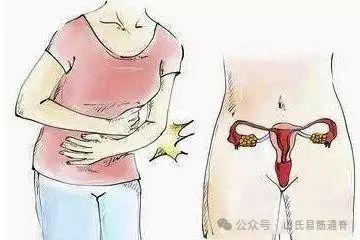
Stasis blood is caused by the accumulation of menstrual blood or postpartum lochia not being expelled, which is due to Qi deficiency in the Chong and Ren channels, combined with invasion by wind and cold, preventing the blood from circulating. Therefore, stasis blood occurs. If stasis blood does not dissipate, it will form a mass, leading to symptoms such as a pale yellow complexion, thirst, aversion to cold, and heavy pain in the waist and abdomen, which can eventually transform into masses.
【Formula】
● Tiao Rong Tang: Treats stasis blood that does not dissipate, with pain in the navel and lower back.
Chuan Xiong, Dang Gui, Shao Yao, Sheng Jiang, Di Huang, San Leng, E Zhu, Bai Zhi, Yan Hu Suo, Pu Huang, Xiang Fu, Ze Lan, Xi Xin, Chuan Bai Jiang, Hou Po (each three fen), La Gui (three fen), Tao Ren (soaked in broth and roasted, two fen), Ban Xia (processed), Gan Cao (roasted, each three fen).
● Sheng Jin Wan: Treats women with long-term accumulation of stasis blood in the abdomen, with unbearable pain.
Mercury (two fen), Sulfur (one tael or more, both ground into fine sand), Palm bark (burned to ash), Qian Qian (crushed and fried until smoke comes out), Carp scales (burned to ash), Natural copper (ground finely, one tael), Qilin Jue (one tael of each), Dog gall (one dried), Dang Gui (one tael, slightly fried and boiled), Yan Hu Suo (half a tael), Meng Chong (one fen, slightly fried and yellowed), Water leech (one fen, fried until slightly yellow), Black snake (one tael, soaked in wine and peeled, slightly yellow), Cinnamon heart (half a tael), Random hair (one tael, burned to ash), Mo Yao (half a tael).
Grind all into a fine powder. Make pills the size of a wutong seed. Take ten pills with hot wine at any time.
● Qilin Jue Wan: Treats women with meridian obstruction and stasis blood in the abdomen, with unbearable pain.
Qilin Jue (half a tael), Mo Yao (half a tael), Nao Sha (yellow dog gall soaked for seven days), Qian Qian (crushed and fried until smoke comes out), Yan Hua (vinegar mixed and fried until dry, one tael), Yan Hu Suo, Chuan Wu (processed and peeled), Bai Fu Zi (half a tael), Dang Gui (one tael, chopped and slightly fried), Arsenic (half a tael), Fu Long Gan (one tael), Meng Chong (one tael, slightly fried and peeled), Ba Dou (one tael, peeled and pitted, ground and wrapped in paper to press out oil), Hong Lan Hua (one tael).
Grind into a fine powder. Use a cast iron pot. Add one liter of vinegar. First add Nao Sha and stir well. Then add half of the medicinal powder. Use slow fire to boil until it becomes a paste. Finally, add the remaining medicinal powder and make pills the size of a small bean. Take five pills with hot wine at any time.
● Dang Gui Wan: Treats women with meridian obstruction, leading to stasis blood in the organs, forming masses.
Dang Gui (one and a half taels, chopped and slightly fried), Bie Jia (half a tael, coated with vinegar and roasted until yellow), Amber (half a tael), Tao Ren (one tael, peeled and roasted until slightly yellow), Chuan Da Huang (chopped and slightly fried), An Zhi Zi, Mu Dan, Water leech (three fen, fried until yellow), Xue Yu, Cinnamon heart (half a tael), Meng Chong (three fen, slightly fried and peeled), Niu Xi (remove the sprouts), Chi Shao.
Grind into a fine powder. Refine with honey and pound for three to two hundred times. Make pills the size of a wutong seed. Take twenty pills with hot wine on an empty stomach.
● Meng Chong San (also known as Tao Ren San): Treats internal cold in the organs, with meridian obstruction, abdominal stasis blood, and stabbing pain.
● Di Long San: Treats women with blood and Qi imbalance, with abdominal stasis blood pain.
Di Long (one fen, slightly fried), Lizard (fried), Chuan Xiong, Cinnamon heart (each one tael), Gan Jiang (processed half a tael), Su Fang Mu (one tael, chopped), Mu Xiang, Pu Huang, Mu Dan, Chi Shao (three fen each), Tao Ren (one tael, peeled and roasted until slightly yellow).
Grind into a fine powder. Take two qian before meals with warm wine.
● Wu Jin San: Treats women with internal cold in the organs, with lingering stasis blood, leading to yellowing and weakness.
Carp scales (three taels), Random hair (two fen), Huai E (three fen), Sang E (three fen), Meng Chong (one fen), Water leech (one fen), Chuan Da Huang (one tael, chopped), Nao Sha, Yan Hua, Niu Xi (remove the sprouts, half a tael each).
Grind all into a fine powder. Place in a ceramic bottle. Cover with a salt mud lid. Dry it. Fire it until it turns red. Gradually reduce the fire. After cooling, add two qian of musk. Grind finely. Take two qian on an empty stomach with hot wine.
● Bai Pu Tang: Treats women with blood stasis and Qi stagnation, leading to pain.
Bai Pu (burned to ash), Dang Gui (two taels), Mu Dan Pi, Chuan Xiong, Chi Shao (each one tael), Shi Xin (one tael), Tao Ren (soaked in broth and roasted, half a tael), Chen Ju Pi (remove the white and roast one tael), Pu Huang (stir-fried on paper, half a tael).
Grind coarsely and sift. Take three qian with one cup of water. Boil until two-thirds remain. Remove the residue and add one cup of Rehmannia juice. Take one qian of Poxiao warm.
● Nao Sha Wan: Treats women with accumulated stasis blood in the organs, causing pain in the heart and abdomen, with yellowing and weakness.
Nao Sha, Sulfur (ground into fine sand), Yan Hua (vinegar mixed and fried until dry), Mo Yao, Mu Dan, Water leech (fried until yellow), Dang Gui (fried), Chuan Da Huang (chopped and slightly fried), Meng Chong (fried until yellow, remove wings and feet, half a tael each).
Grind into a fine powder. Mix with sand and grind until uniform. Refine with honey and pound for three to two hundred times. Make pills the size of a green bean. Take five pills with hot wine on an empty stomach.
● Tao Ren Tang: Treats women with menstrual stasis due to cold, leading to abdominal pain and yellowing.
Tao Ren, Da Huang (raw, each one tael), Gui (remove the coarse skin), Dang Gui (cut and roast, each three fen), Gan Cao (roasted, half a tael), Meng Chong (remove the head and feet, ten pieces each).
Grind coarsely and sift. Take three qian with one cup of water. Boil until two-thirds remain. Remove the residue and take half a qian of Mang Xiao mixed in.
● Yan Hua San (from “Sheng Hui Fang”): Treats women with lingering stasis blood in the abdomen, causing pain.
Yan Hua (mixed with vinegar and fried until dry, one tael), Chuan Wu (one fen, processed and peeled), Gui Jian (one fen, fried until yellow), Meng Chong (one fen, fried until yellow), Tao Ren (one tael, soaked in broth and roasted until slightly yellow).
Grind into a fine powder. Take half a qian before meals with hot wine.
● Xue Sha Tang: Treats women with menstrual stasis and Qi stagnation, leading to pain.
Xue Sha, Da Huang (raw, each one tael), He Ye (burned to ash, three to seven pieces), Gui (remove the coarse skin), An Zhi Zi (each one tael).
Grind coarsely and sift. Take three qian with one cup of water. Boil until one cup remains. Add one qian of Poxiao and take warm on an empty stomach.
● Da Huang Tang: Treats women with stasis blood that does not dissipate and bruises.
Da Huang (raw), Tao Ren (soaked in broth and roasted until slightly yellow, each one tael), Gui (remove the coarse skin, half a tael), Sheng Gan Di Huang (roasted, one tael), Yu Li Ren (remove the skin, ground half a tael).
Grind coarsely and sift. Take three qian with half a cup of water and wine. Boil until two-thirds remain. Remove the residue and take warm.
● Treats women with abdominal distension due to blood stasis and Qi stagnation, leading to headache, dry throat, chest tightness, nausea after eating, and fullness in the lower abdomen, weakness in the limbs, and fatigue…
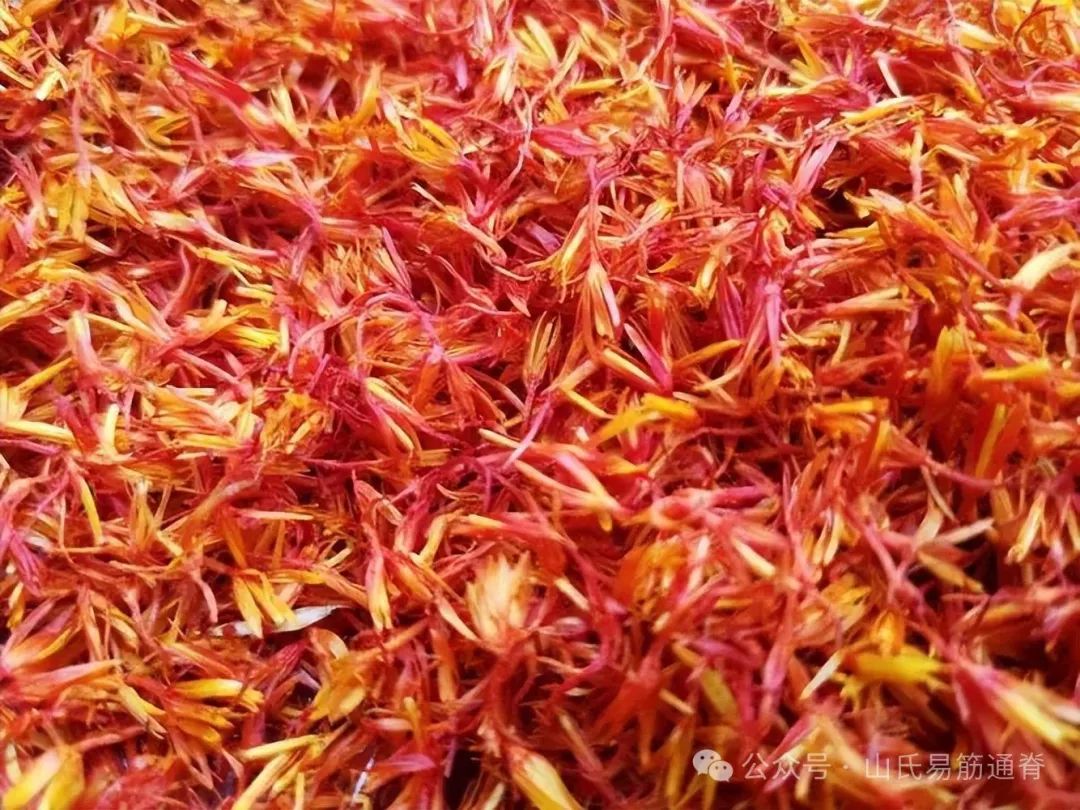
Ancient physicians saved lives and added a rich chapter to the development of TCM. Among them, one physician is known as the “First Person to Transform Stasis”, who proposed the theory that “the cause of all diseases is due to blood stasis”. Combining over 40 years of clinical practice experience, he wrote the book “Yilin Gai Cuo”, summarizing over 60 types of Qi deficiency syndromes and 50 types of blood stasis syndromes. Today, I will share with you the four soups of this TCM master for transforming stasis: Tong Qiao Huo Xue Tang, Xue Fu Zhu Yu Tang, Ge Xia Zhu Yu Tang, and Shen Tong Zhu Yu Tang, to clear the stasis in the head and face, limbs, chest, upper abdomen, and lower limbs!
The First Person to Transform Stasis Blood: Wang Qingren
In the “Suwen* Regulation of Menstruation”, it is stated: “What exists in the human body is blood and Qi.” “The pathways of the five organs all originate from the marrow, to circulate Qi and blood. When blood and Qi are not harmonious, various diseases arise.” Since Zhang Zhongjing first proposed the term “stasis blood” in the Eastern Han Dynasty, by the time of Wang Qingren in the Qing Dynasty, he had inherited the thoughts of his predecessors and established the theory of stasis blood.
To explore blood stasis, Wang Qingren did something “shocking”; during the strict feudal etiquette of the Qing Dynasty, he entered the execution ground, dissected corpses, and observed them. Through extensive dissections, he deduced the phenomenon of blood stasis causing disease. He believed that if a person’s vital energy is deficient and cannot reach the blood vessels, the blood will stagnate and coagulate. Symptoms such as dizziness, tinnitus, numbness and tremors in the hands and feet, mental fatigue, and drowsiness are actually due to vital energy deficiency causing stasis; while diseases such as coronary heart disease, angina, chest pain, cerebral thrombosis, headache, and paralysis are all related to stasis!If stasis blood does not dissipate, new blood cannot be generated, worsening the stasis, leading to systemic pain, creating a vicious cycle. Therefore, as adults, we must always be vigilant about—activating blood and transforming stasis.“Zhu Yu Tang” to Remove All Stasis Blood
01
Blood Stasis in the Head and Face—Tong Qiao Huo Xue Tang
Clinical application: Stroke, headache, dizziness, skull decompression, dementia, brain tumors, hair loss, facial cyanosis, vitiligo, rosacea, etc.
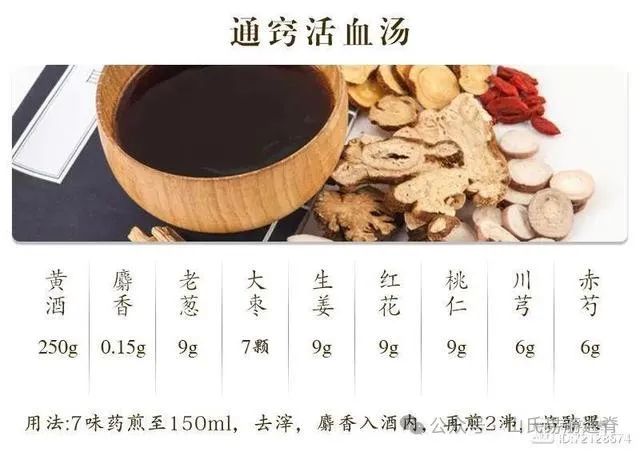
When stasis blood is in the brain, the heart’s blood cannot be generated, and blocked pathways can lead to the above conditions. Musk is the monarch herb in this formula because it is good at opening orifices; its aromatic properties can traverse the twelve meridians and connect with blood. Wang Qingren used Chi Shao (Red Peony) and Chuan Xiong (Ligusticum) to activate blood, and used Tao Ren (Peach Kernel) and Hong Hua (Safflower) to resolve stasis and unblock the meridians, with ginger and jujube to harmonize the spleen and stomach, and scallions to guide the Yang Qi to unblock the meridians, ensuring that blood activation and orifice opening are achieved.
02
Blood Stasis in the Chest—Xue Fu Zhu Yu Tang
Clinical application: Chest pain, palpitations, insomnia with vivid dreams, coronary heart disease, angina, rheumatic heart disease, chest bruises, costochondritis, hypertension, hyperlipidemia, thromboangiitis obliterans, neurosis, and sequelae of concussion.
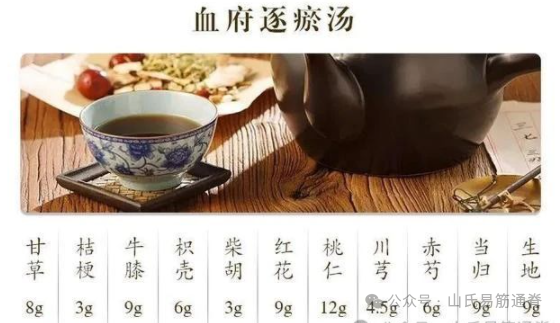
What Wang Qingren referred to as “blood stasis in the chest” is actually blood stasis blocking the chest, causing Qi movement to stagnate, and the clear Yang being restrained from rising, leading to symptoms such as chest pain, fixed pain, and dark red tongue with stasis spots. This formula has been explained by Baicao Jun, so I will not elaborate further. For those who want to understand it, you can click on 【Xue Fu Zhu Yu Tang】.
03Blood Stasis in the Upper Abdomen—Ge Xia Zhu Yu Tang
Clinical application: Chronic active hepatitis, diabetic nephropathy, ectopic pregnancy, chronic ulcerative colitis, primary dysmenorrhea, uterine fibroids, etc.
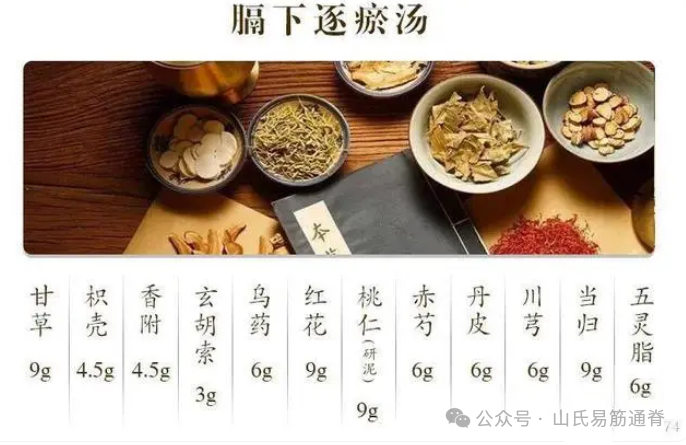
“Ge Xia” refers to the spleen, stomach, liver, and small intestine, the area above the navel, often caused by liver Qi stagnation and blood stasis leading to abdominal masses, fixed pain, and abdominal heaviness, and chronic diarrhea. In this formula, Chi Shao, Chuan Xiong, and Dang Gui nourish and activate blood, dispelling stasis without harming Yin blood; Tao Ren, Hong Hua, Wu Ling Zhi, and Dan Pi are used to break stasis and disperse masses, while Xiang Fu, Wu Yao, Zhi Ke, and Xuan Hu Suo move Qi and relieve pain, with Gan Cao harmonizing the herbs. Regulating Qi and soothing the liver is even better, focusing on breaking the stasis in the upper abdomen and relieving pain.
04
Shoulder, Neck, and Leg Pain—Shen Tong Zhu Yu Tang
Clinical application: Rheumatoid arthritis, wind-heat, wind-damp myalgia, rheumatoid arthritis, low back and leg pain, muscle and joint pain, soreness, numbness, heaviness, etc.
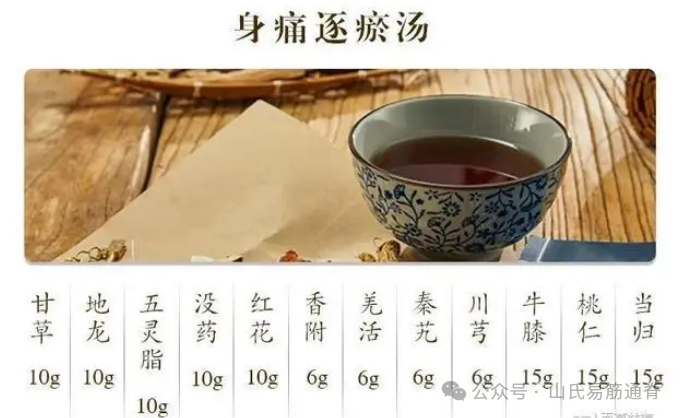
When the body is affected by wind, cold, damp, and heat evils, it can lead to soreness, numbness, and difficulty in flexion and extension of the limbs and joints, due to Qi and blood obstruction. Shen Tong Zhu Yu Tang uses Qin Jiao and Qiang Huo to dispel wind and eliminate dampness, while Tao Ren, Hong Hua, Dang Gui, and Chuan Xiong activate blood and resolve stasis, and Mo Yao, Ling Zhi, and Xiang Fu are used to move Qi and blood, relieve pain, while Niu Xi and Di Long unblock the meridians and benefit the joints. Shen Tong Zhu Yu Tang activates blood, resolves stasis, dispels wind, eliminates dampness, and relieves pain.
